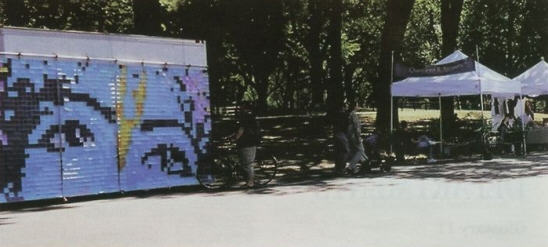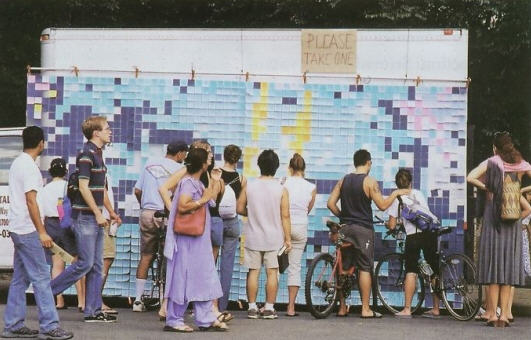
Piotr Adamski, of the Hare Krsna temple at 26 Second Avenue in New York City, created the display of Krsna's face shown here using hundreds of Post-it notes containing BTG's "Vedic Thoughts" (see inside back cover). When the Society for Environmental Graphic Design (SEGD), an international non-profit organization based in Washington, D.C., announced the winners of its 2003 Design Awards, the display was among the winners. Here's the write-up from SEDG's Web site (sedg.org):
Juror Award ("Please Take One")
Location: Central Park, New York, NY
Designer: Piotr Adamski, New York, NY
Fabricator: Piotr Adamski
Client: The International Society for Krishna Consciousness of 26 Second Avenue

For the Krishna Festival in August 2002, representatives of the Hare Krishna movement in New York wanted to provide a way to communicate the Vedic philosophy in an inexpensive (up to $300) but appealing way. The mosaic was a board consisting of 1800 Post-it notes in various colors recently released by 3M. The image was a close-up of the eyes of Krishna, the personification of God in traditional Vedic culture, based on a photo of deities from one of the main temples in Imphal, Manipur, India. The notes were each printed with quotes from the philosophical masterpieces of Vedic literature, creating a wall of spiritual thoughts to be noticed, read, and taken by passersby. Piotr Adamski wrote "Please Take One" on a cardboard sign, and the message worked. On a sunny afternoon, more than half of the 1800 notes were noticed, read, and taken. The goal was achieved: Vedic wisdom was absorbed and passed on to an otherwise unreachable group of people. Taking into account the short life of festivals, the project was deliberately constructed to be destroyed, disappear, and taken away in small pieces. The artwork was sacrificed as a whole in order to extend the existence of its message.
Jury Comment
"This is an extremely clever, ephemeral, low environmental impact, religious communication art piece. Viewers become participants, interacting with the piece, and gradually deconstruct the Vedic image as they take messages away. The Post-it notes were a perfect low-budget choice."
